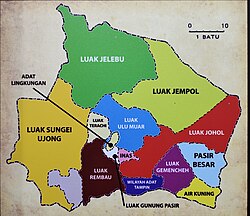This article needs additional citations for verification. (February 2016) |
Jelebu District | |
|---|---|
| Daerah Jelebu | |
| Other transcription(s) | |
| • Jawi | جلبو |
| • Chinese | 日叻务县 |
| • Tamil | ஜெலுபு |
 Location of Jelebu District in Negeri Sembilan | |
 | |
Location of Jelebu District in Malaysia | |
| Coordinates: 3°0′N 102°05′E / 3.000°N 102.083°E | |
| Country | |
| State | |
| Seat | Kuala Klawang |
| Local area government(s) | Jelebu District Council |
| Government | |
| • District officer | Syahrunizam Shahwan[1] |
| Area | |
• Total | 1,349.89 km2 (521.20 sq mi) |
| Population (2010)[3] | |
• Total | 37,287 |
| • Density | 28/km2 (72/sq mi) |
| Time zone | UTC+8 (MST) |
| • Summer (DST) | UTC+8 (Not observed) |
| Postcode | 71600 - 71650 |
| Calling code | +6-06 |
| Vehicle registration plates | N |
Jelebu District Council Majlis Daerah Jelebu مجليس دايره جيليبو | |
|---|---|
| Type | |
| Type | |
| History | |
| Founded | 28 August 1980 |
| Leadership | |
President | Abdul Rahim A.Aziz |
| Meeting place | |
 | |
| Wisma MDJ, Jalan Simpang Pertang, 71600 Kuala Klawang, Jelebu, Negeri Sembilan. | |
| Website | |
| www | |
Jelebu | |
|---|---|
| Luak Jelebu لواق جلبو | |
 Luak of Jelebu relative to other luaks in Negeri Sembilan | |
| Country | Malaysia |
| State | Negeri Sembilan |
| Adat institution | Undang of Jelebu |
| Government | |
| • Undang | Maarof Mat Rashad |
The Jelebu District (Negeri Sembilan Malay: Jolobu; Jawi: جلبو) is the second largest district in Negeri Sembilan, Malaysia after Jempol, with a population over 40,000. Jelebu borders on the Seremban District to its west and Kuala Pilah District to its south, Jempol District to its southeast, Bentong and Bera Districts, Pahang to its east and Hulu Langat District, Selangor to the north. Jelebu is a suburban district with blossoming semi-agricultural industry. Jelebu is also a parliamentary constituency of the Dewan Rakyat in the Malaysian Parliament. Kuala Klawang is the principal town of the district.
Jelebu has an infamous recorded history of British and Japanese colonization as compared to other parts of Negeri Sembilan. Numerous priceless colonial artefacts were discovered in the small semi-agricultural town of Sungai Muntoh, which was once a prosperous mining town a century ago. These artefacts are now displayed in the state museum. Titi and neighbouring Sungai Muntoh were the most developed towns of all mining sites in Jelebu. The booming tin industry was one of the main reasons for the massacre in Titi, where more than 1,500 people, mainly Chinese, were killed. Altogether, about 5,000 people were killed by the Japanese-led army during World War II.
- ^ "Pejabat Daerah Dan Tanah Jelebu - Utama". Archived from the original on 22 September 2017.
- ^ "Laman Web Rasmi Pejabat Daerah Dan Tanah Jelebu - Profil Daerah Jelebu". jelebu.ns.gov.my. Archived from the original on 1 December 2017. Retrieved 27 November 2017.
- ^ "Population Distribution and Basic Demographic Characteristics, 2010" (PDF). Department of Statistics, Malaysia. Archived from the original (PDF) on 22 May 2014. Retrieved 19 April 2012.

